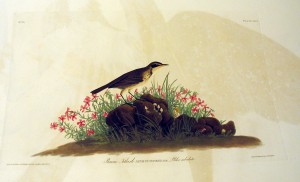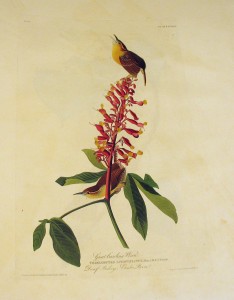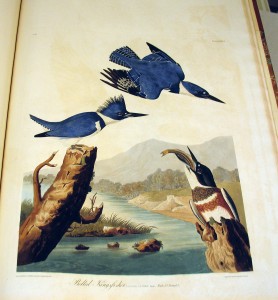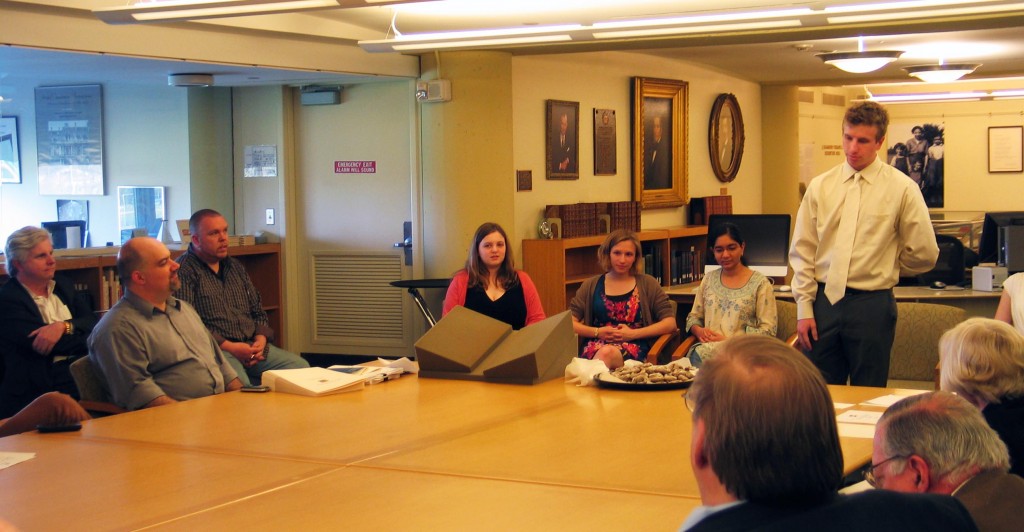 “I shot two of these birds whilst traversing one of the extensive prairies of our North-western States. Five of them had been running along the foot-path before me, for some time. I at first looked upon them as of the Common Brown Titlark species (Anthus Spinoletta), but as they rose on the wing, the difference of their notes struck me, and, shooting at them, I had the good fortune to kill two, which I discovered, on examination, to be of a new and distinct species, although in the general appearance of their plumage they were very nearly allied to the Brown Titlark. The rest I pursued in vain, and was forced to abandon the chase on account of the approach of night, and the necessity of preparing for a rest after a long walk.”
“I shot two of these birds whilst traversing one of the extensive prairies of our North-western States. Five of them had been running along the foot-path before me, for some time. I at first looked upon them as of the Common Brown Titlark species (Anthus Spinoletta), but as they rose on the wing, the difference of their notes struck me, and, shooting at them, I had the good fortune to kill two, which I discovered, on examination, to be of a new and distinct species, although in the general appearance of their plumage they were very nearly allied to the Brown Titlark. The rest I pursued in vain, and was forced to abandon the chase on account of the approach of night, and the necessity of preparing for a rest after a long walk.”
–J. J. Audubon, Ornithological Biography, I (1831), 408 [excerpted].
Comments Off on The Prairie Titlark (Audubon “bird of the week”)
 “The Tyrant Fly-catcher, or, as it is commonly named, the Field Martin, or King Bird, is one of the most interesting visitors of the United States, where it is to be found during spring and summer, and where, were its good qualities appreciated as they deserve to be, it would remain unmolested. But man being generally disposed to consider in his subjects a single fault sufficient to obliterate the remembrance of a thousand good qualities, even when the latter are beneficial to his interest, and tend to promote his comfort, persecutes the King Bird without mercy, and extends his enmity to its whole progeny. This mortal hatred is occasioned by a propensity which the Tyrant Fly-catcher now and then shews to eat a honey-bee, which the narrow-minded farmer looks upon as exclusively his own property, although he is presently to destroy thousands of its race, for the selfish purpose of siezing upon the fruits of their labours, which he does with as little remorse as if nature’s bounties were destined for man alone.”
“The Tyrant Fly-catcher, or, as it is commonly named, the Field Martin, or King Bird, is one of the most interesting visitors of the United States, where it is to be found during spring and summer, and where, were its good qualities appreciated as they deserve to be, it would remain unmolested. But man being generally disposed to consider in his subjects a single fault sufficient to obliterate the remembrance of a thousand good qualities, even when the latter are beneficial to his interest, and tend to promote his comfort, persecutes the King Bird without mercy, and extends his enmity to its whole progeny. This mortal hatred is occasioned by a propensity which the Tyrant Fly-catcher now and then shews to eat a honey-bee, which the narrow-minded farmer looks upon as exclusively his own property, although he is presently to destroy thousands of its race, for the selfish purpose of siezing upon the fruits of their labours, which he does with as little remorse as if nature’s bounties were destined for man alone.”
–J. J. Audubon, Ornithological Biography, I (1831), 403 [excerpted].
Comments Off on The Tyrant Fly-catcher (Audubon “bird of the week”)
 “The quickness of the motions of this active little bird is fully equal to that of the mouse. Like the latter, it appears and is out of sight in a moment, peeps into a crevice, passes rapidly through it, and shews itself at a different place the next instant. When satiated with food, or fatigued with these multiplied exertions, the little fellow stops, droops its tail, and sings with great energy a short ditty something resembling the words come-to-me, come-to-me, repeated several times in quick succession, so loud, and yet so mellow, that it is always agreeable to listen to them. During spring, these notes are heard from all parts of the plantations, the damp woods, the swamps, the sides of creeks and rivers, as well as from the barns, the stables and the piles of wood, within a few yards of the house.”
“The quickness of the motions of this active little bird is fully equal to that of the mouse. Like the latter, it appears and is out of sight in a moment, peeps into a crevice, passes rapidly through it, and shews itself at a different place the next instant. When satiated with food, or fatigued with these multiplied exertions, the little fellow stops, droops its tail, and sings with great energy a short ditty something resembling the words come-to-me, come-to-me, repeated several times in quick succession, so loud, and yet so mellow, that it is always agreeable to listen to them. During spring, these notes are heard from all parts of the plantations, the damp woods, the swamps, the sides of creeks and rivers, as well as from the barns, the stables and the piles of wood, within a few yards of the house.”
–J. J. Audubon, Ornithological Biography, I (1831), 399 [excerpted].
Comments Off on The Great Carolina Wren (Audubon “bird of the week”)

We were thrilled to see over 70 people (families and friends of graduating seniors) come through the Watkinson today! On display is, of course, the famous Audubon (Birds of America), several books recently acquired and given (including the 2nd Folio of Shakespeare), as well as a small student exhibition and the main exhibit on Hyam Plutzik.

Comments Off on Commencement weekend!
 We bid a fond farewell with best wishes to Michael Kozek ’13, who has worked for the Watkinson for his entire time at Trinity (with the exception of the “study abroad” semester he spent in Argentina). Majoring in Language & Cultural Studies and Political Science, Michael wrote a thesis in Spanish entitled “Logros, Desafíos y Justicia: La cultura política LGBTQ en Argentina e Italia.” In the fall, Michael will attend graduate school at the University of Chicago to pursue Latin American studies.
We bid a fond farewell with best wishes to Michael Kozek ’13, who has worked for the Watkinson for his entire time at Trinity (with the exception of the “study abroad” semester he spent in Argentina). Majoring in Language & Cultural Studies and Political Science, Michael wrote a thesis in Spanish entitled “Logros, Desafíos y Justicia: La cultura política LGBTQ en Argentina e Italia.” In the fall, Michael will attend graduate school at the University of Chicago to pursue Latin American studies.
Michael is shown here standing by a small exhibition he recently curated (on display through June 15) entitled “The Corvo Papers: The OSS in Italy during WW II.” The exhibit offers a selection of items from a collection of intelligence reports, photos, and correspondence from fascist Italy (1943-45), given to Trinity by William Corvo, the son of Biagio “Max” Corvo, a decorated Major in the Office of Strategic Services (OSS, the precursor to the CIA). The collection includes formerly sensitive documents (and some very graphic photos) that reveal how the OSS contributed to a strategic advantage that helped to bring down Mussolini’s administration and turn Italy toward the Allied cause.
Comments Off on Swan Song (and a great research opportunity!)
 “The more usual range of the Belted Kingfisher . . . is confined to the rivers and creeks that abound throughout the United States; all of which, according to the seasons, are amply supplied with various fishes, on the fry of which this bird feeds. It follows their course up to the very source of the small rivulets; and it is not unusual to hear the hard, rapid, rattling notes of our Kingfisher, even amongst the murmuring cascades of our higher mountains. When the bird is found in such sequestered situations, well may the angler be assured that trout is abundant. Mill-ponds are also favorite resorts of the Kingfisher, the usual calmness of the water in such places permitting it to discover its prey with ease.”
“The more usual range of the Belted Kingfisher . . . is confined to the rivers and creeks that abound throughout the United States; all of which, according to the seasons, are amply supplied with various fishes, on the fry of which this bird feeds. It follows their course up to the very source of the small rivulets; and it is not unusual to hear the hard, rapid, rattling notes of our Kingfisher, even amongst the murmuring cascades of our higher mountains. When the bird is found in such sequestered situations, well may the angler be assured that trout is abundant. Mill-ponds are also favorite resorts of the Kingfisher, the usual calmness of the water in such places permitting it to discover its prey with ease.”
–J. J. Audubon, Ornithological Biography, I (1831), 395 [excerpted].
Comments Off on The Belted Kingfisher (Audubon “bird of the week”)
 “The common name given to this bird in the Eastern and Middle districts of our Union is that of Quail, but in Western and Southern states, the more appropriate appellation of Partridge is bestowed upon it. It is abundantly met with in all parts of the United States, but more especially towards the interior. In the states of Ohio and Kentucky, where they are very abundant, they are to be seen in the markets, both dead and alive, in large quantities.
“The common name given to this bird in the Eastern and Middle districts of our Union is that of Quail, but in Western and Southern states, the more appropriate appellation of Partridge is bestowed upon it. It is abundantly met with in all parts of the United States, but more especially towards the interior. In the states of Ohio and Kentucky, where they are very abundant, they are to be seen in the markets, both dead and alive, in large quantities.
This species performs occasional migrations from the north-west to the south-east, usually in the beginning of October, and somewhat in the manner of the Wild Turkey. For a few weeks at this season, the northwestern shores of the Ohio are covered with flocks of Partridges. They ramble through the woods along the margin of the stream, and generally fly across towards evening. Like the Turkeys, many of the weaker Partridges often fall into the water, while thus attempting to cross, and generally perish; for although they swim surprisingly, they have not muscular power sufficient to keep up a protracted struggle, although, when they have fallen a few yards of the shore, they easily escape being drowned.”
–J. J. Audubon, Ornithological Biography, I (1831), 388 [excerpted].
Comments Off on The Virginian Partridge (Audubon “bird of the week”)

Yesterday afternoon we enjoyed the presentations of our 2012-13 cohort of Creative Fellows, two of whom (Georgia Summers ’15 and Laika Abdulali ’13) will be continuing to work through the summer.
 Georgia read a tantalizing excerpt from her paranormal novel based in the Watkinson. It promises to be a page-turner!
Georgia read a tantalizing excerpt from her paranormal novel based in the Watkinson. It promises to be a page-turner!
Laika described the fascination (and unexpected humor) she found in several of our travel narratives to the Far East, which she is using as a basis to write several short stories. She also commented that the ability to browse the Watkinson and read freely among the rare books provided her with a great way to de-stress from writing her thesis (Political Science).
Julia Falkowski ’13 surprised the crowd by bringing in “chocolate jumbles,” which she made from an 1886 recipe book which was used to advertise the products of a food company.
 Michael Benson ’13 treated us to two tracks of his mash-up of old-time jazz and modern rap and hip-hop. And Anastasia Edwards ’13 stunned everyone with a beautiful dress she designed using our 19th-century Paris fashion material.
Michael Benson ’13 treated us to two tracks of his mash-up of old-time jazz and modern rap and hip-hop. And Anastasia Edwards ’13 stunned everyone with a beautiful dress she designed using our 19th-century Paris fashion material.
President Jones, the Trustees of the Watkinson, and the students, staff, and faculty who came to hear the presentations were delighted, and asked many questions. We look forward to receiving applications (DUE MAY 31) from students who will constitute the 2013-14 cohort!
Comments Off on Creative Fellows presentations
 “The Tyrant Fly-catcher, or, as it is commonly named, the Field Martin, or King Bird, is one of the most interesting visitors of the United States, where it is to be found during spring and summer, and where, were its good qualities appreciated as they deserve to be, it would remain unmolested. But man being generally disposed to consider in his subjects a single fault sufficient to obliterate the remembrance of a thousand good qualities, even when the latter are beneficial to his interest, and tend to promote his comfort, persecutes the King Bird without mercy, and extends his enmity to its whole progeny. This mortal hatred is occasioned by a propensity which the Tyrant Fly-catcher now and then shews to eat a honey-bee, which the narrow-minded farmer looks upon as exclusively his own property, although he is presently to destroy thousands of its race, for the selfish purpose of siezing upon the fruits of their labours, which he does with as little remorse as if nature’s bounties were destined for man alone.”
“The Tyrant Fly-catcher, or, as it is commonly named, the Field Martin, or King Bird, is one of the most interesting visitors of the United States, where it is to be found during spring and summer, and where, were its good qualities appreciated as they deserve to be, it would remain unmolested. But man being generally disposed to consider in his subjects a single fault sufficient to obliterate the remembrance of a thousand good qualities, even when the latter are beneficial to his interest, and tend to promote his comfort, persecutes the King Bird without mercy, and extends his enmity to its whole progeny. This mortal hatred is occasioned by a propensity which the Tyrant Fly-catcher now and then shews to eat a honey-bee, which the narrow-minded farmer looks upon as exclusively his own property, although he is presently to destroy thousands of its race, for the selfish purpose of siezing upon the fruits of their labours, which he does with as little remorse as if nature’s bounties were destined for man alone.”








